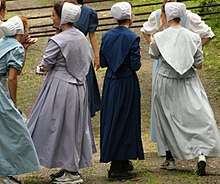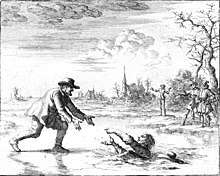River Brethren
The River Brethren are any of certain Christian groups originating in 1770, during the Radical Pietist movement among German colonists in Pennsylvania.[1] In the 17th century, Mennonite refugees from Switzerland had settled their homes near the Susquehanna River in the northeastern United States.

| Part of a series on |
| Anabaptism |
|---|
 Dirk Willems (picture) saves his pursuer. This act of mercy led to his recapture, after which he was burned at the stake near Asperen (etching from Jan Luyken in the 1685 edition of Martyrs Mirror |
|
Background |
|
Distinctive doctrines |
|
Largest groups |
|
Related movements |
|
|
Their religious guides, Jacob and John Engle, joined with the revival, and their followers were often known by their locality: a group of brethren from north of Marietta, Pennsylvania, on the east side of the Susquehanna River came to be known as the River Brethren.[2] Perhaps they were baptized in the Susquehanna.
The initial spiritual leader of the brethren was Martin Boehm, evangelical preacher, who was excluded from the Mennonite Church. He later became bishop of the Church of the United Brethren in Christ.
The River Brethren distanced themselves from Boehm and the United Brethren movement.
Influenced by the Schwarzenau Brethren (named Dunkers), the River Brethren developed a conviction that trine (triple, in allusion to the Trinity) immersion, foot washing, adherence to plain dress, was the scriptural form of religion. They opposed war, alcohol, tobacco, and worldly pleasures.
Nevertheless, they maintained their identity and did not join the Dunker movement. Jacob Engle is one of the early leaders who promoted trine immersion. The first confessional statement of this group was formulated around 1780.
As of 2010 there are four bodies of River Brethren in about 300 congregations:
- Brethren in Christ Church
- Calvary Holiness Church
- Old Order River Brethren (also called Yorker Brethren)
- United Zion Church
Common to the Radical Piestic tradition, the River Brethren hold experience meetings, in which "members [are seen] testifying of God's work in their lives in bringing them to salvation and daily living."[3] When a member has a conversion experience, he or she begins taking part in the experience meeting and then requests baptism.[3]
Several factions of the River Brethren withdrew in the middle of the 19th century, including the Yorker Brethren and the United Zion Church, while the main body took the name Brethren in Christ, by which a group of Mennonites is also known.
There were about 11,000 members in the United States and Canada in 1992. They carry out missionary work in Asia and Africa.
References
- Shantz, Douglas H. (2013). An Introduction to German Pietism: Protestant Renewal at the Dawn of Modern Europe. JHU Press. ISBN 9781421408804.
- Bender, Harold S. (1959). "River Brethren". Global Anabaptist Mennonite Encyclopedia Online. Retrieved 2010-11-26.
- Bronner, Simon J. (2015). Encyclopedia of American Folklife. Routledge. ISBN 9781317471950.